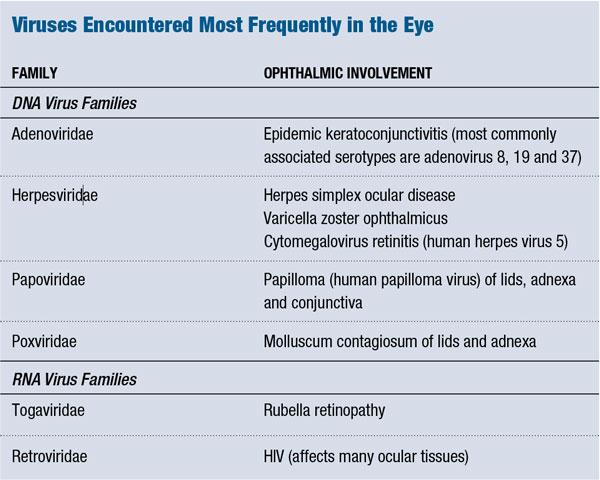 |
From the Latin virus, meaning “poison” or “slimy liquid,” these pathogens are recognized as the cause of several diseases. We now know that viruses are small but powerful microorganisms that have widespread effects on the body—including the ocular structures and tissues.
Furthermore, Ebola, enterovirus, dengue and Middle East respiratory syndrome (MERS)—viruses many clinicians did not think much about a short time ago—are now causing a great deal of illness and worry worldwide.
How to Go Viral
In the late 1890s, German scientists Friedrich Loeffler and Paul Frosch concluded that foot-and-mouth disease in animals happens not by a bacteria or toxin, but by an “ultravisible causative agent”—a minute particle, smaller than any bacteria, that is capable of reproduction under certain conditions.1,2

|
|
| This patient with herpes (varicella) zoster ophthalmicus was successfully treated with oral antiviral medication. |
This was an early clue to the nature of viruses; they are genetic entities that lie somewhere in the grey area between living and non-living states.
When found outside of the host cell, a virus is metabollically inert. The virus exists as a protein coat, or capsid, that surrounds either DNA or RNA, which codes for the virus elements.
The entire infectious particle, called a virion, consists of the outer shell of protein and the nucleic acid within. The simplest viruses contain only enough RNA or DNA to encode four proteins, while the most complex can encode 200 or more proteins.3
A virus cannot reproduce by itself. So, when it comes into contact with a host cell, the virus inserts its genetic material and takes over the host’s functions. Instead of its usual products, the infected cell produces viral protein and genetic material. Thus, once the virus infects a susceptible cell, it can direct that cell to produce more viruses.
In a normal cell, DNA is copied to make mRNA by a process called transcription. The information stored in mRNA is used (by ribosomes) to assemble proteins from amino acids, a process called translation.3,4,5
The normal sequence is:
![]()

In DNA viruses, such as varicella zoster, when viral genetic material enters a cell, it is replicated, transcribed (mRNA is produced) and translated (proteins are produced from the mRNA).3-5 By this process, the host cell uses the genetic instructions in the virus to make more viruses:
![]()

In some RNA viruses, the viral RNA serves as mRNA after infection. The RNA of some viruses serves as a template to synthesize more RNA within the host cell. Some of the replicated RNA serves as mRNA and is used to produce proteins, while the remainder is packaged in new viral particles.3,5
Retroviruses (a family of RNA viruses) use RNA as their genetic material, but the host cell must synthesize a “DNA copy” of the RNA before it can be transcribed or translated. This task is aided by the action of an enzyme known as reverse transcriptase. HIV is an example of a retrovirus.5
|
|

|
|
|
This transmission electron micrograph reveals rubella virions in the process of budding from the host cell surface to be freed into the host’s system. The rubella virus is known to be the cause of measles. Congenital rubella can result in retinopathy. |
Some viruses remain dormant inside host cells for long periods, causing no obvious damage (a stage known as the lysogenic phase). But when a dormant virus is stimulated, it enters the lytic phase. Here, new viruses are formed, self-assemble and burst out of the host cell, killing it and going on to infect other cells.3,5,6
A virus that infects only bacteria is called a bacteriophage.3,5,6 Viruses that infect animal or plant cells are referred to generally as animal viruses or plant viruses. Most animal viruses do not cross phyla, and some (e.g., poliovirus) infect only closely related species, such as primates.
The host-cell range of some animal viruses is further restricted to a limited number of cell types because only these cells have appropriate surface receptors to which the virions can attach.
Outbreaks and Vaccines
The term outbreak describes the sudden rise in the incidence of a disease. An epidemic occurs when an infectious disease spreads rapidly to many people—well beyond what is expected within a country or a part of a country.
When the infection takes place in several countries at the same time, it turns into a pandemic––an outbreak of global proportions. It happens when a novel virus emerges among humans.7 The virus causes serious illness and is easily human transmissible.
The emergence of vaccines has been one of the greatest advances in public health. A vaccination is the injection of a killed or weakened organism that produces immunity in the body against that organism. While vaccines produce immunization, some infections also cause immunization after an individual recovers from that disease.
Through use of vaccines, we have eradicated smallpox and nearly eliminated wild poliovirus. The benefits of vaccines appear to significantly outweigh the risks. However, no vaccine is 100% safe or effective for everyone because each person’s body reacts to vaccines differently.

|
|
Viral Eye Disease
Along with the nose and mouth, eyes are a main access point for viruses. In addition, systemic viral infection from other areas of the body may manifest in ocular tissues, causing potentially sight-threatening complications. (See “Viruses Encountered Most Frequently in the Eye."
)
In forthcoming columns, we’ll present an update on each of these viruses frequently encountered within the review of systems. First up in March: HIV.
1. Witz J. A reappraisal of the contribution of Friedrich Loeffler to the development of the modern concept of virus. Arch Virol. 1998;143(11):2261-3.
2. Rott R, Siddell S. One hundred years of animal virology. J Gen Virol. 1998 Nov;79 (Pt 11):2871-4.
3. Carter J, Saunders V. Virology: Principles and Applications, 2nd ed. Hoboken, NJ: Wiley; 2013:1-65.
4. Taylor MW. Viruses and Man: A History of Interactions. Switzerland: Springer International Publishing; 2014:1-40.
5. Genes and Gene Expression. BioChemWeb.org: The Virtual Library of Biochemistry and Cell Biology. Available at: www.biochemweb.org/genes.shtml. Accessed December 7, 2014.
6. Madigan MT, Martinko J (eds.). Brock Biology of Microorganisms, 11th ed. Upper Saddle River, NJ: Prentice Hall; 2006.
7. Porta M (ed.). A Dictionary of Epidemiology, 6th ed. New York: Oxford University Press; 2014:209.

